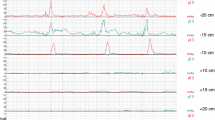Abstract
The colonic mucosa of patients with sigmoidostomies, who were operated on for rectal cancer, and treated thereafter for different periods of time with daily water irrigations to obtain complete evacuation, was investigated by histologic and histochemical methods. Microscopic examination of the test specimens showed that the epithelial continuity, the characteristic brush border, and the positive mucous reaction to PAS and Alcian blue-Alcian yellow methods were not significantly changed with respect to controls. In some test specimens a remarkable number of mitoses were evident in the crypts. Since this could result from water irrigation stimuli and/or might represent an early manifestation of a restoved carcinogenetic process, specific investigations were performed on the 0-acylated sialic acids of the colonic mucins, which have been reported to represent markers of early malignant changes in colorectal epithelial cells. The results did not reveal alterations of the sialomucins in the treated specimens with respect to controls.
Similar content being viewed by others
References
Culling CF, Reid PE, Dunn WL. The effect of saponification upon certain histochemical reactions of the epithelial mucins of the gastrointestinal tract. J Histochem Cytochem 1971;19:654–62.
Cullings CF, Reid PE, Dunn WL. A new histochemical method for the dentification and visualization of both side chain acylated and nonacylated sialic acids. J Histochem Cytochem 1976;24:1225–30.
Culling CF, Reid PE. Specific techniques for the identification of 0-acylated sialic acids in colonic mucins. J Microsc 1980;119:415–25.
Filipe MI. Mucins in the human gastrointestinal epithelium: a review. Invest Cell Pathol 1979;2:195–216.
Reid PE, Culling CF, Dunn WL, Ramey CW, Magil AB, Clay MG. Differences between the O-acetylated sialic acids of the epithelial mucins of human colonic tumors and normal controls: a correlative chemical and histochemical study. J Histochem Cytochem 1980;28:217–22.
Goldman H, Antonioli DA. Mucosal biopsy of the rectum, colon, and distal ileum. Hum Pathol 1982;13:981–1012.
Miller HR, Nawa Y. Immune regulation of intestinal goblet cell differentiation: specific induction, of nonspecific protection against Helminths? Nouv Rev Fr Hematol 1979;21:31–45.
Gebbers JO, Laissaue JA, Otto HF. Modern aspects of functional morphology of the colon. Coloproctology 1981;3:211–26.
Reid PE, Culling CF, Dunn WL, Ramey CW, Clay MG. Chemical and histochemical studies of normal and diseased human gastrointestinal tract. I. A comparison between histologically normal colon, colonic tumors, ulcerative colitis and diverticular disease of the colon. Histochem J 1984;16:235–51.
Lipkin M, Quastler H. Cell retention and incidence of carcinoma in several portions of the gastrointestinal tract. Nature 1962;194:1198–9.
Lipkin M, Deschner E. Comparative analysis of cell renewal in the gastrointestinal tract of newborn hamster. Exp Cell Res 1968;59:1–12.
Tanaka J. Autoradiographic studies on the cell proliferation of the human gastric mucosa in supravital condition. Acta Pathol Jpn 1968;18:307–18.
Steenbeck L, Wolff G. Histoautoradiographische Untersuchungen der Menschilichen Magenschleimhaut bei chronischer Gastritis und Magenkarzinom. Arch Geschwulsforch 1971;38:132–8.
Theuring F, Schultz M, Erbstösser E, von Bossányi P. Das Regenerationsverhalten des menschlichen Digestionstraktes unter verschiedenen pathologischen Bedigungen. Eine in-vitro-autoradiographische Studie. Acta Histochem (Jena) 1983;27:211–7.
Romagnoli P, Filipponi F, Bandettini L, Brugnola D. Increase of mitotic activity in the colonic mucosa pf patients with colorectal cancer. Dis Colon Rectum 1984;27:305–8.
Biasco G, Miglioli M, Minarini A. Rectal cell renewal as biological marker of cancer risk in ulcerative colitis. In: Sherlock P, Morson BC, Barbara L, Veronesi U, eds. Precancerous lesions of the gastrointestinal tract. New York: Raven Press, 1983:261–8.
Maskens AP. Mechanisms of colorectal carcinogenesis in animal models: possible implications in cancer prevention. In: Sherlock P, Morson BC, Barbara L, Veronesi U (eds). Precancerous lesions of the gastrointestinal tract. New York: Raven Press, 1983:223–5.
Lipkin M. Phase 1 and Phase 2 proliferative lesions of colonic epithelial cells in diseases leading to colonic cancer. Cancer 1974;34:878–8.
Winawer SJ, Sherlock P, Schottenfeld D, Miller DG. Screening for colon cancer. Gastroenterology 1976;70:783–9.
Palmer RH. Bile acid heterogeneity and the gastrointestinal epithelium: from diarrhea to colon cancer. J Lab Clin Med 1979;94:655–60.
Murray WR, Blackwood A, Trotter JM, Calman KC, Mackay C. Faecal, bile acids and clostridia in the aetiology of colorectal cancer. Br J Cancer 1980;41:923–8.
Reddy SB, Cohen LA, McCoy GD, Hill P, Weisburger JH, Wynder EL. Nutrition and its relationship to cancer. Adv Cancer Res 1980;32:238–345.
Deschner EE. The influence of dietary colic acid and betasitosterol on MNU-induced colon carcinogenesis. In: Sherlock P, Morson BC, Barbara L, Veronesi U eds. Precancerous lesions of the gastrointestinal tract. New York: Raven Press, 1983:219–20.
Author information
Authors and Affiliations
Additional information
Read at the XXI Concegno Società Italiana di Istochimica, Capri, Italy, May 21 to 23, 1986.
About this article
Cite this article
Galliani, I., Sant, P., Baratta, B. et al. Effect of water irrigations on human colonic mucosa structure after sigmoidostomy. Dis Colon Rectum 30, 453–456 (1987). https://doi.org/10.1007/BF02556496
Issue Date:
DOI: https://doi.org/10.1007/BF02556496




